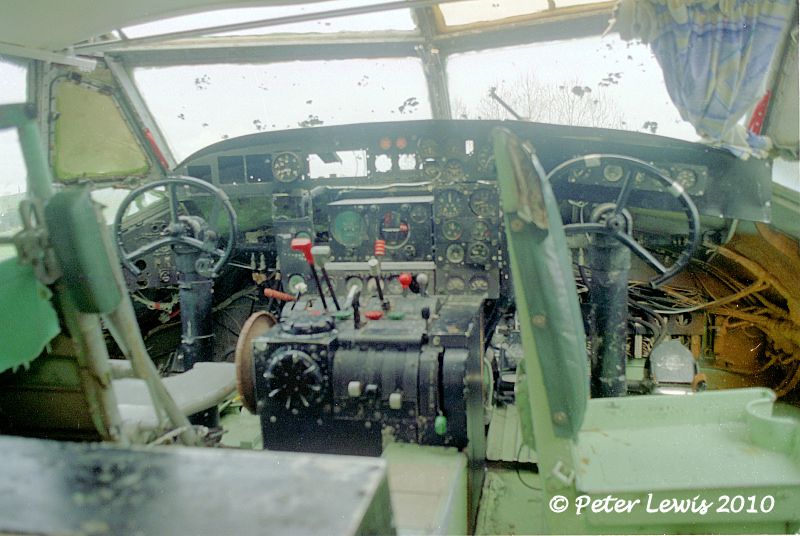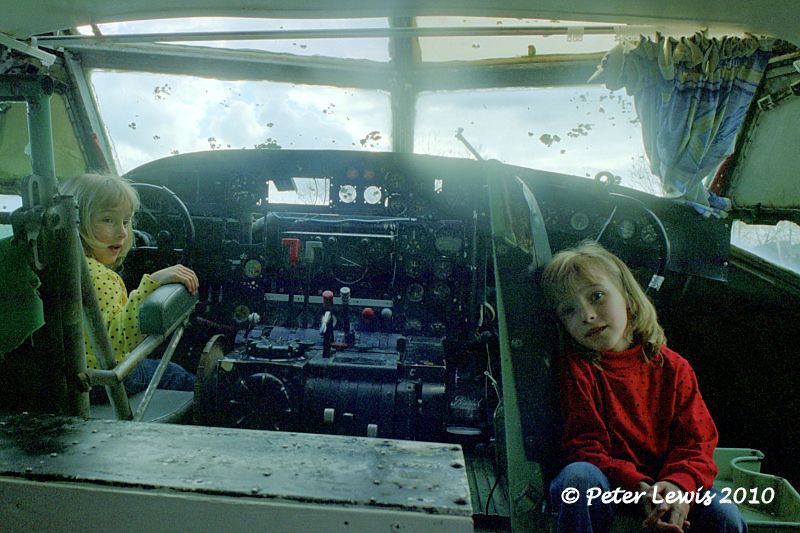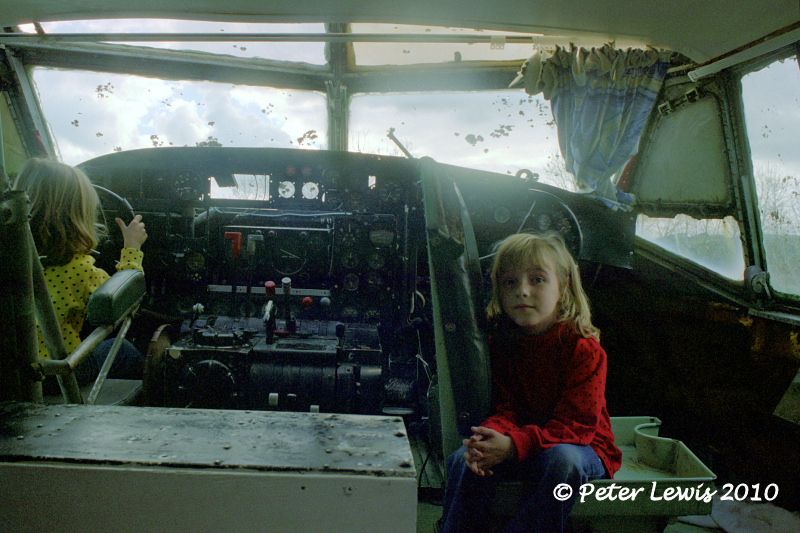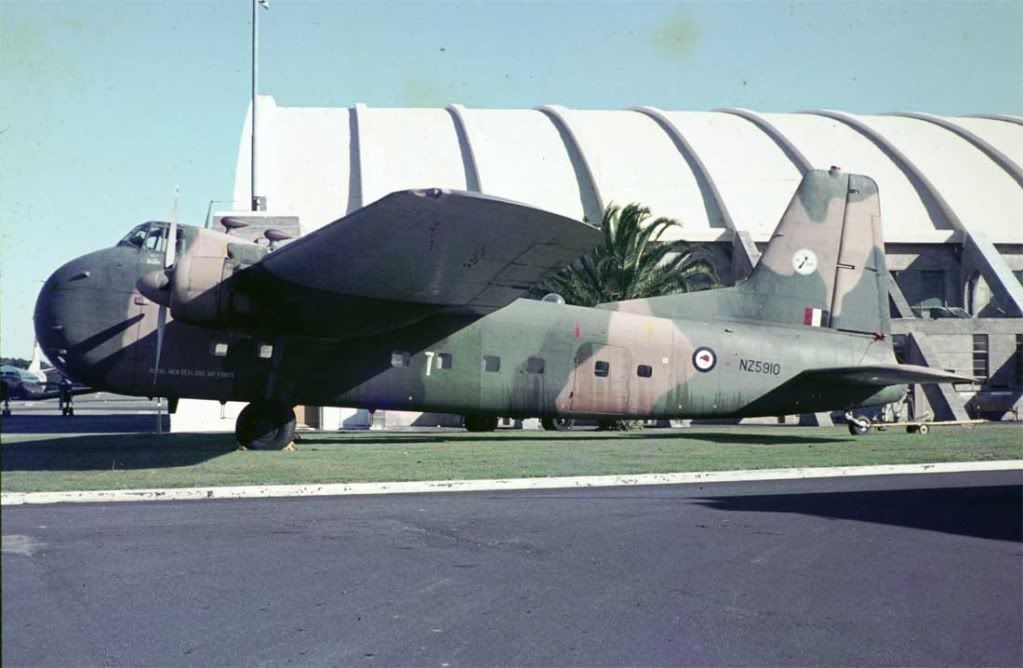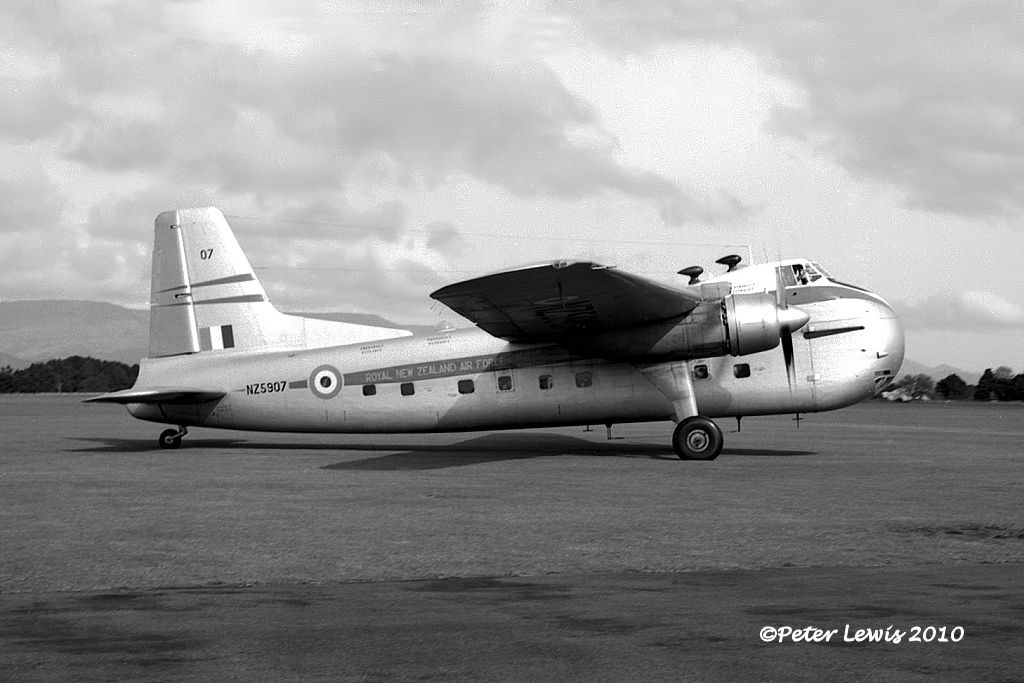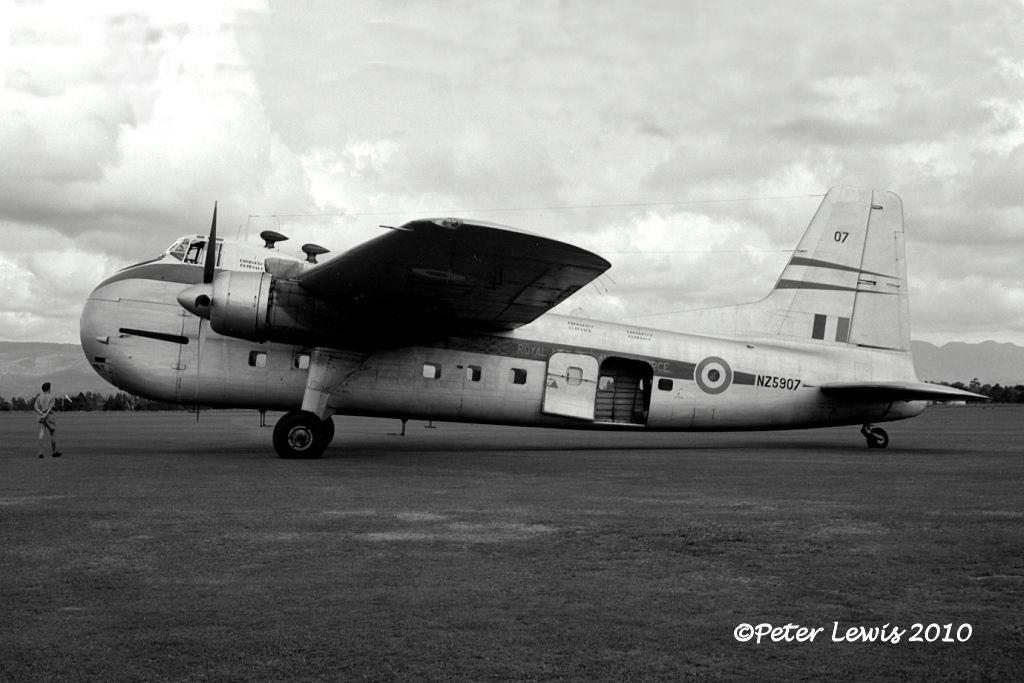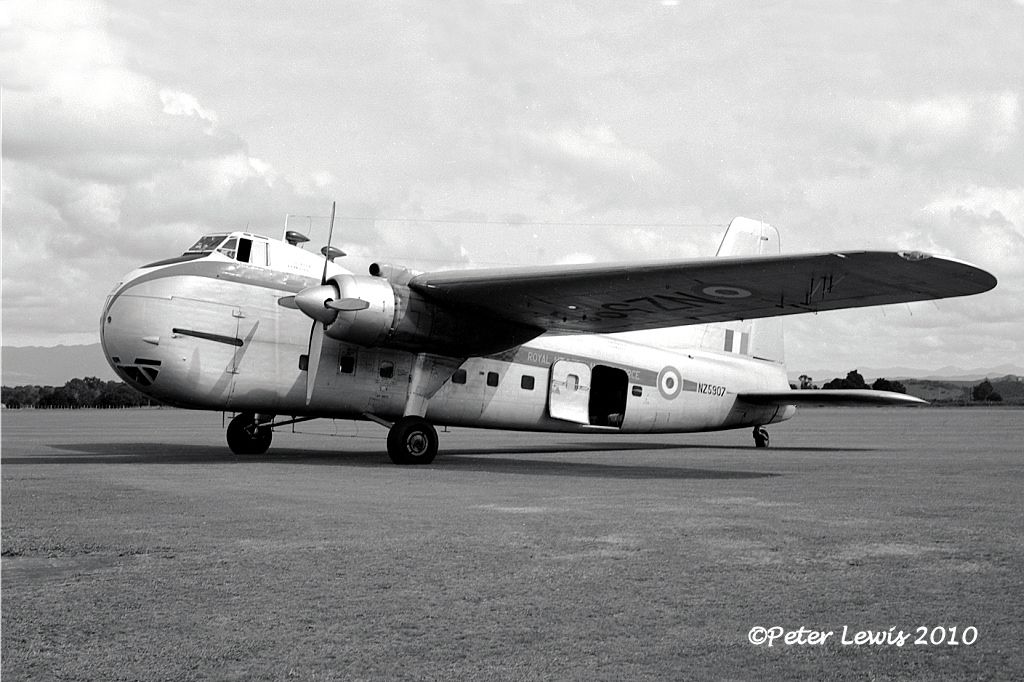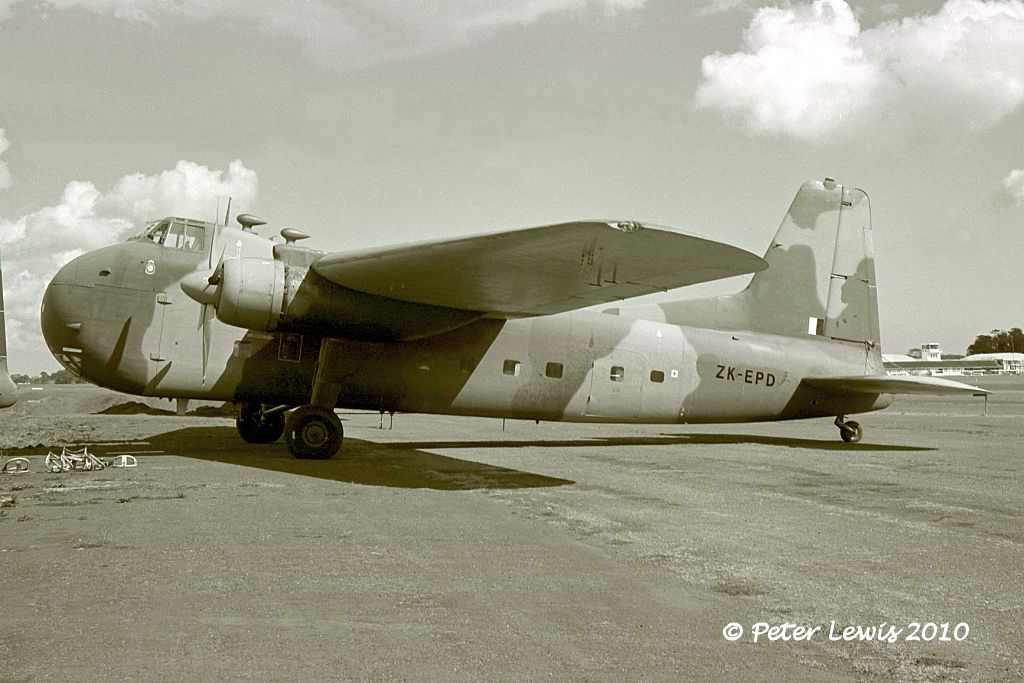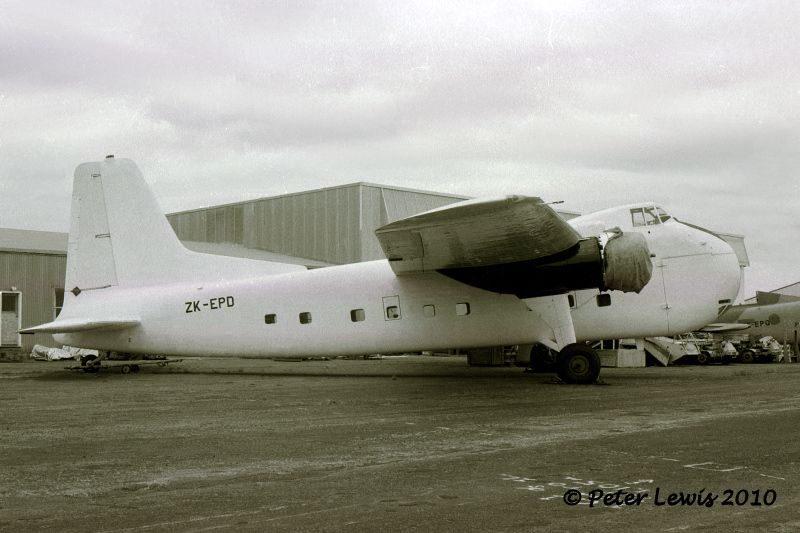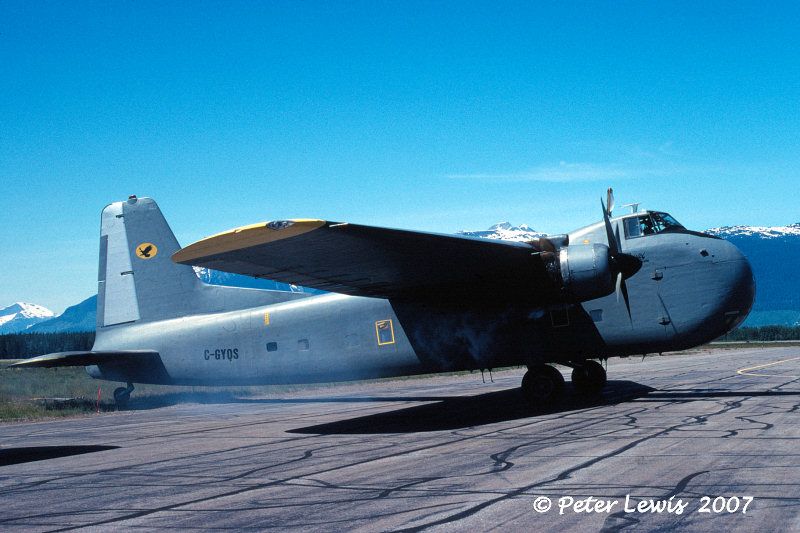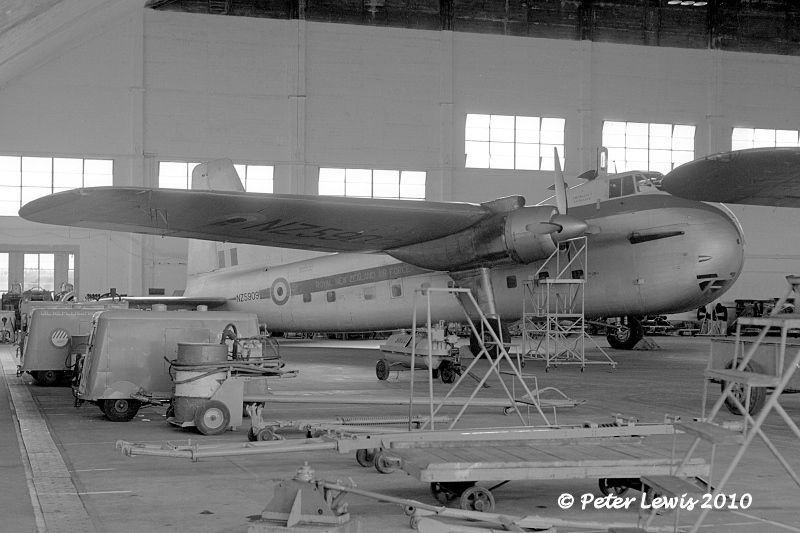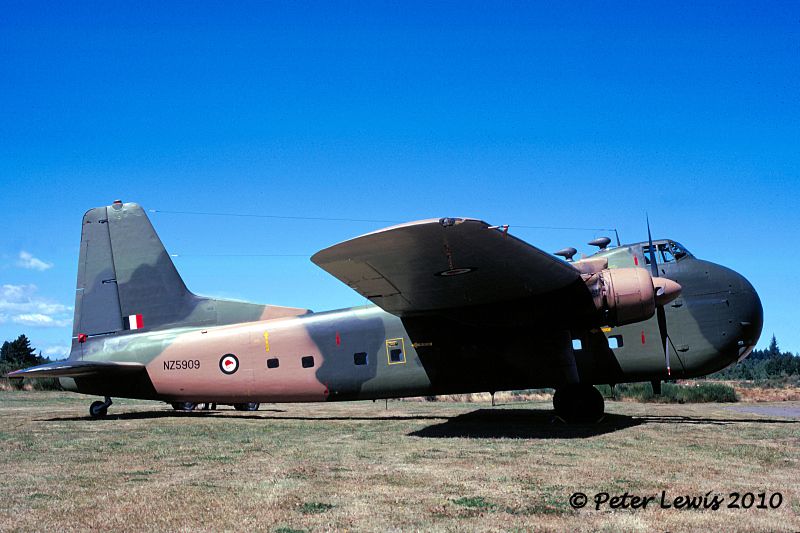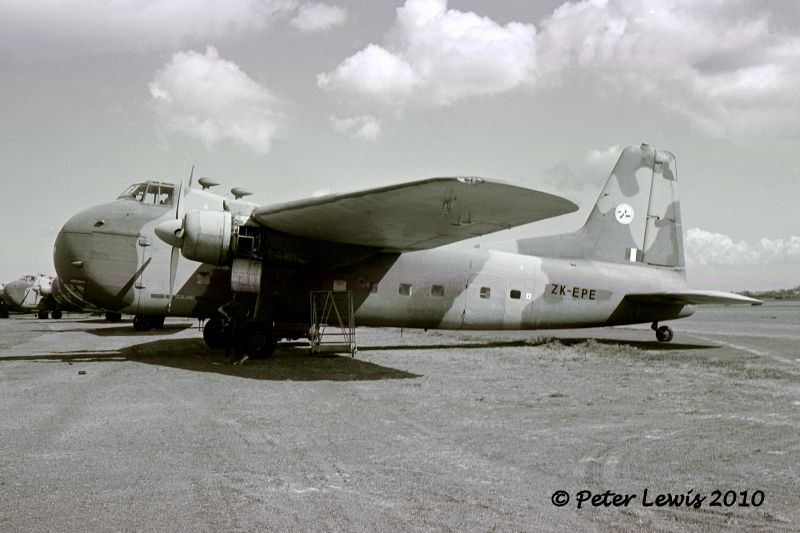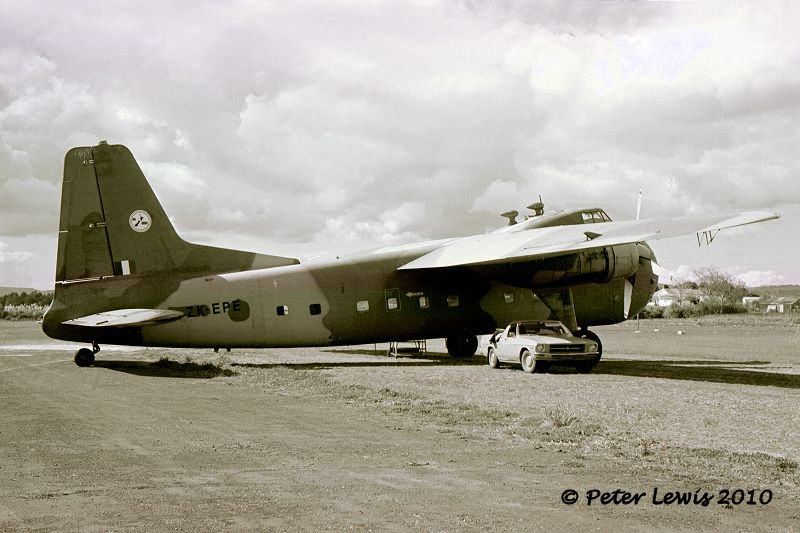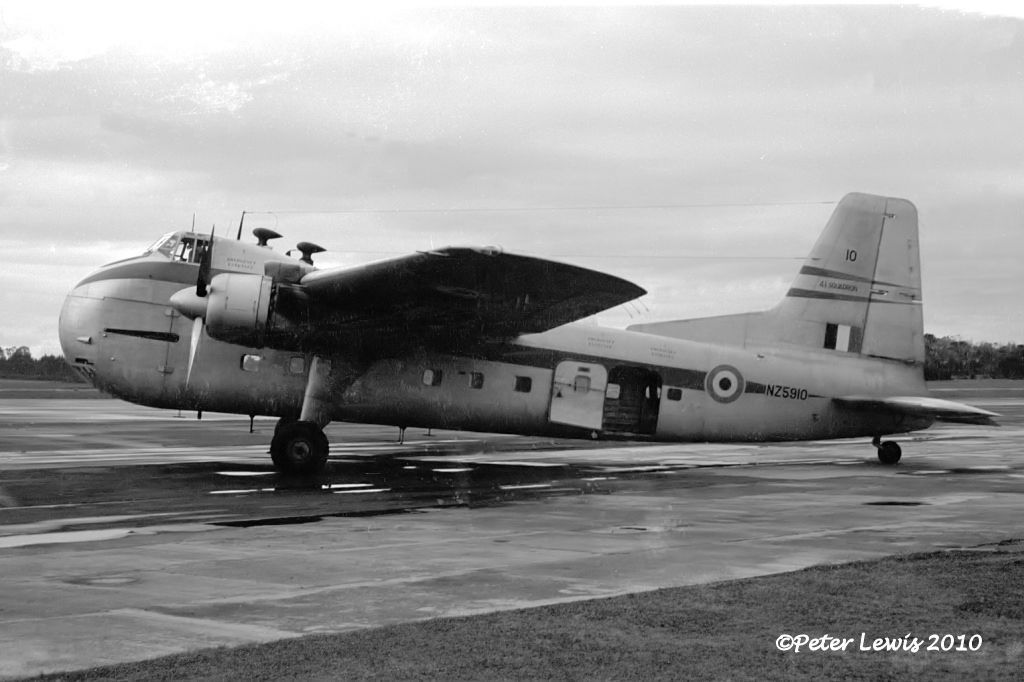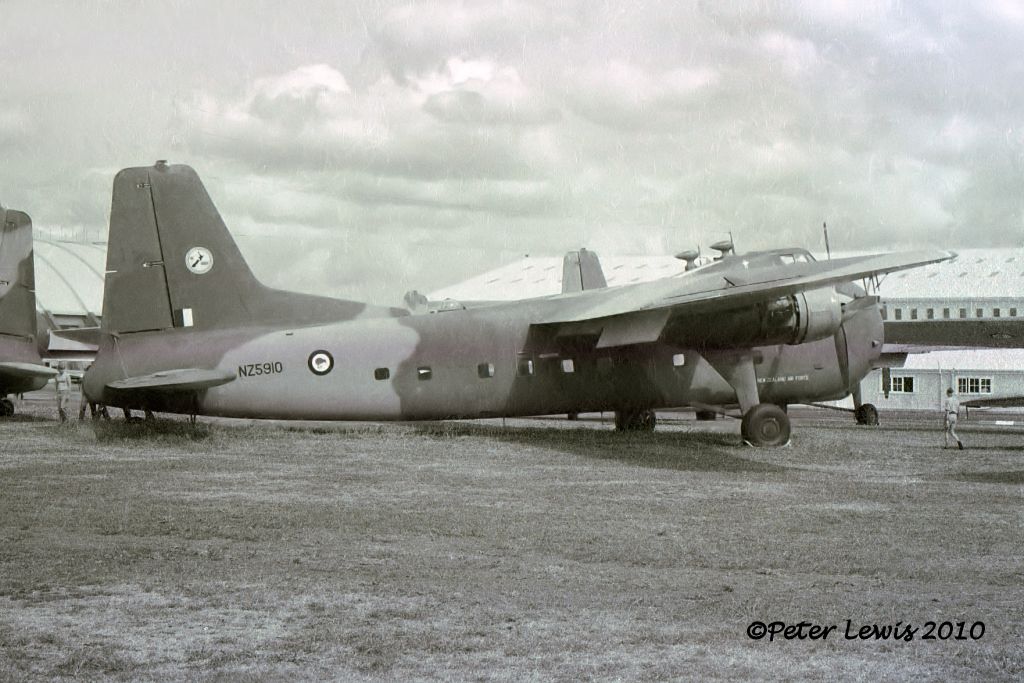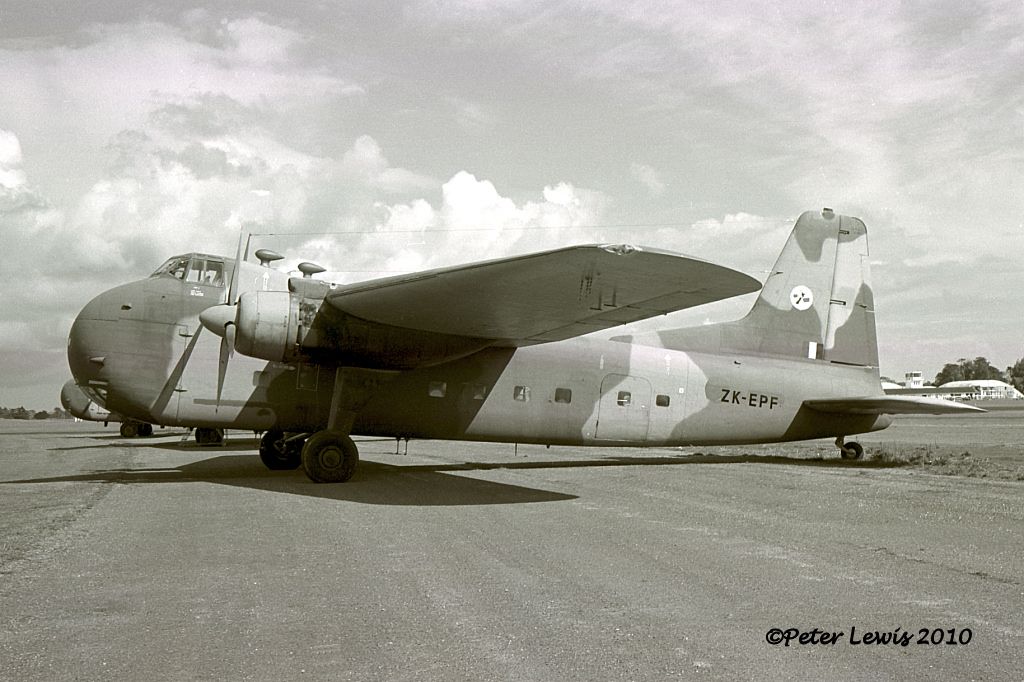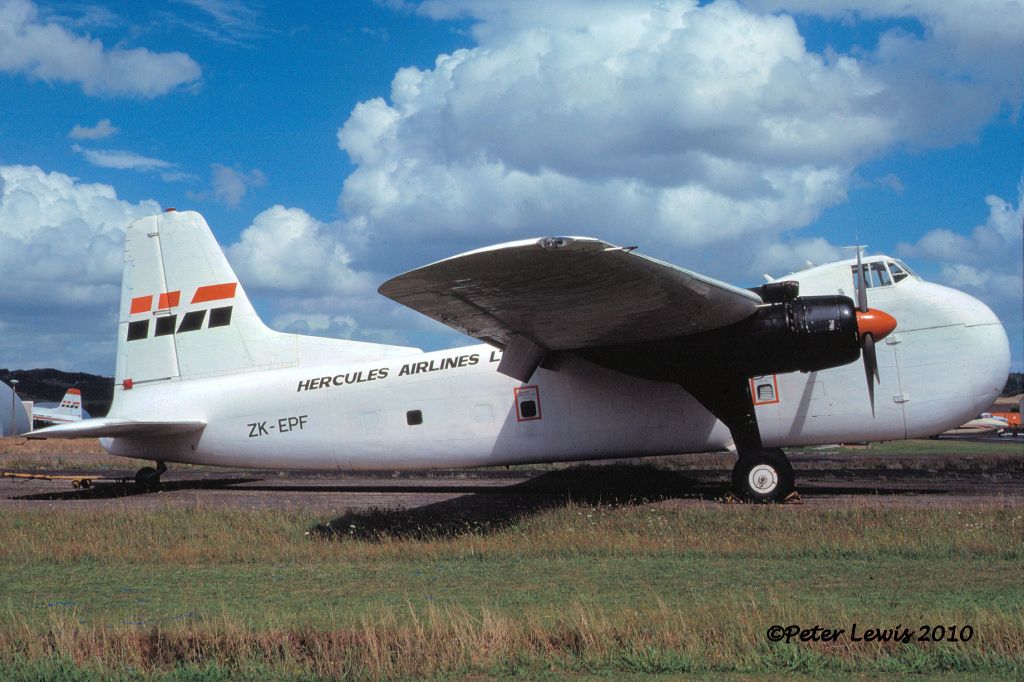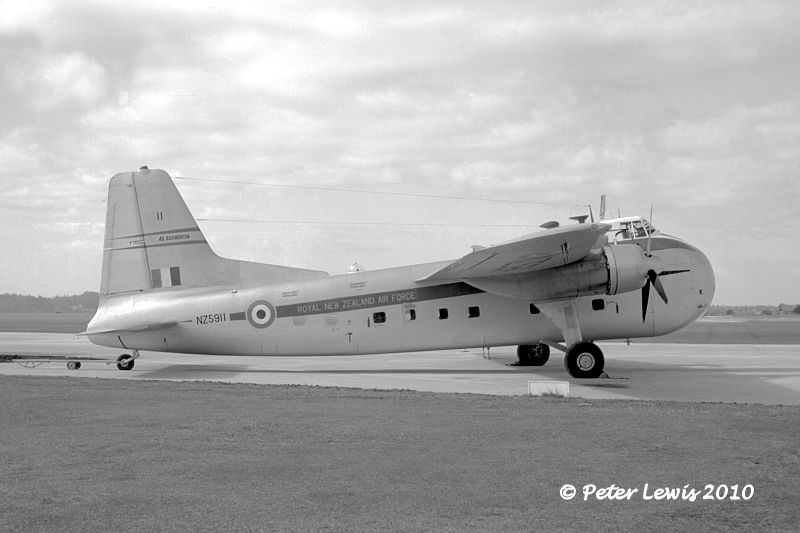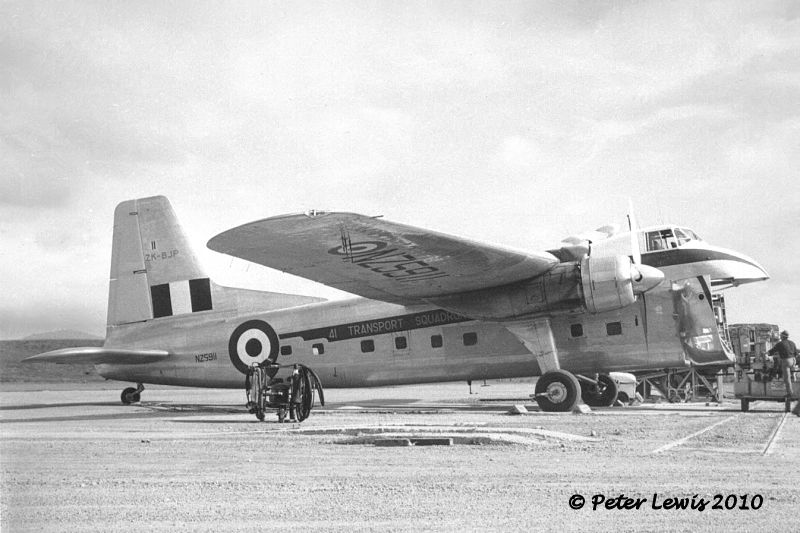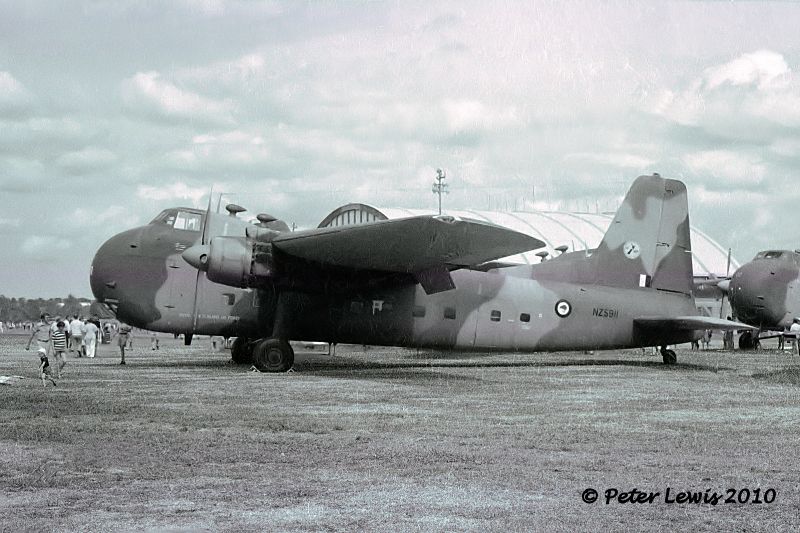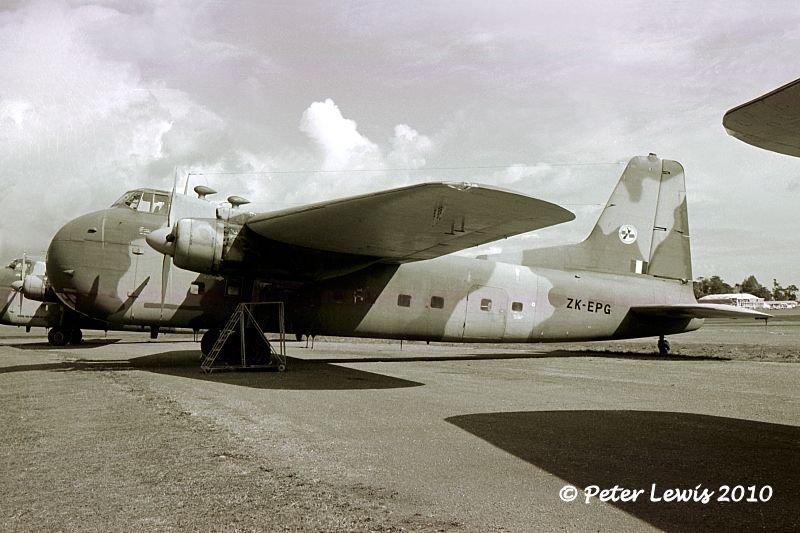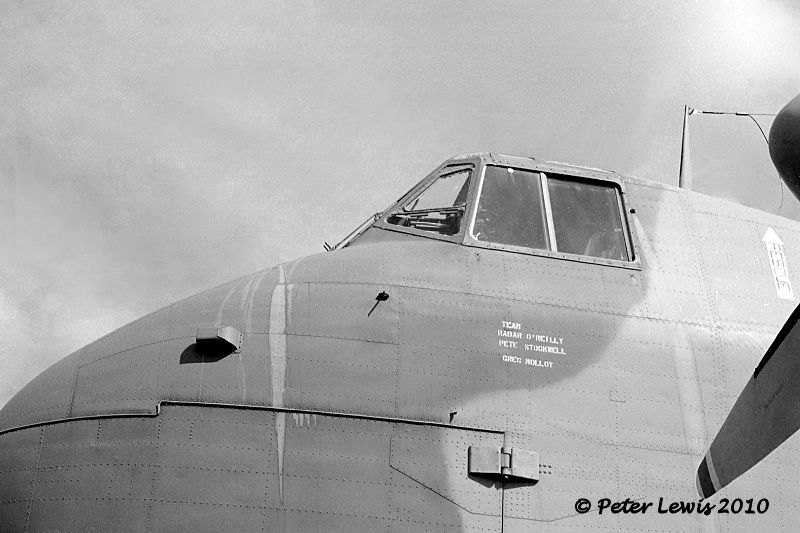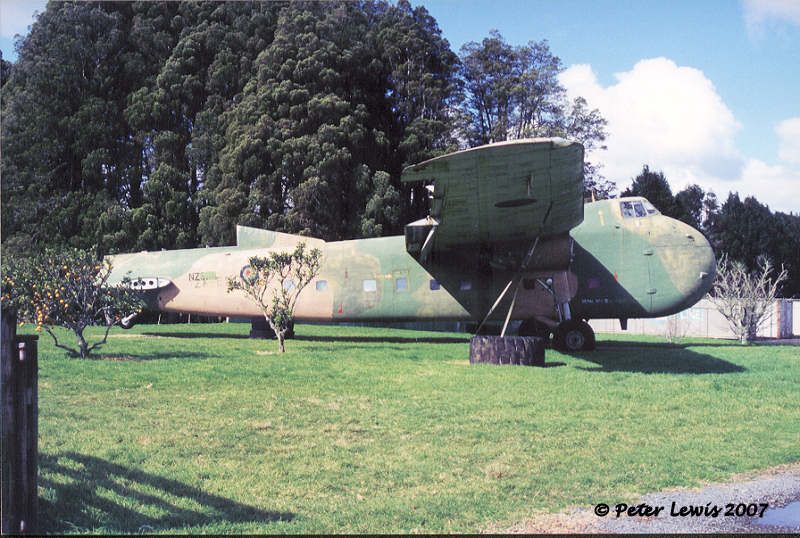Post by Peter Lewis on Sept 29, 2010 21:06:13 GMT 12
The next photo sequence of New Zealand aircraft will be the Bristol Freighter.
As the civil and military histories of these aircraft are very closely intertwined, I will post this thread here rather than in the civil section.
As Kiwi as jandals, jelly tips and number 8 wire, the Bristol Frightener became an iconic feature of the local aviation scene over 40 years from the early 1950s. My favorite tall story involves an aviation person who visited Wellington during a fine weather day in the mid-1970s. At the conclusion of his visit he commented to his host on the Bristol that had been performing non-stop circuits at the airport for the entire day. He was astounded to be told that what he had seen was not one aircraft, but a parade of Safe-Air Freighters maintaining a continuous service across Cook Strait for the day, and that this was not an uncommon event.
The first B170 to be seen in NZ was G-AIMC 'Merchant Venturer' which arrived at Whenuapai in July 1947 on a Bristol sales drive. This aircraft was demonstrated to local operators and potential buyers during its visit, and carried the first Bristol freight operations across Cook Strait later that month.
Departing to Australia via Norfolk Island in August, G-AIMC was destroyed when its parking brake failed while on a steep strip in New Guinea in November 1947.
Freighter G-AIMC during its 1947 tour at Harewood (Dakman)
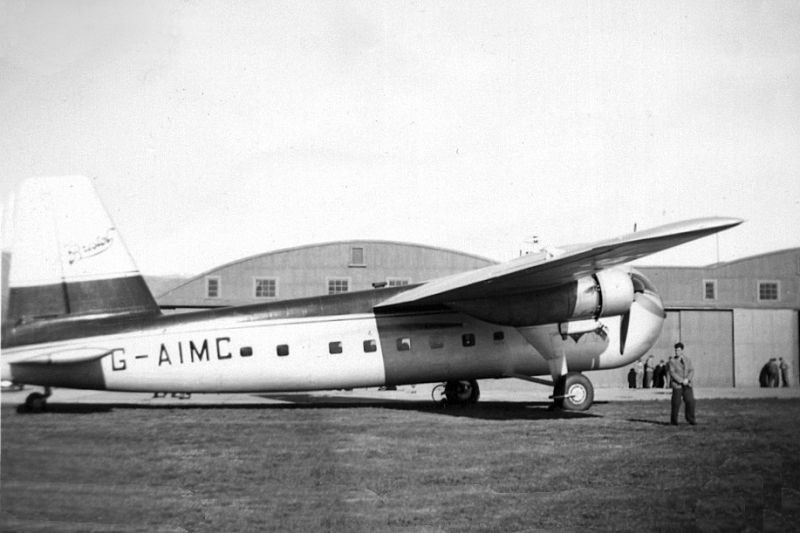
After Straits Air Freight Express Ltd. had gained the cross-strait freight contract from New Zealand Government Railways, initial operations were carried out by chartered Chinese Curtiss C-46 Commando until the two Bristol Freighters ordered by the new firm arrived.
The first of these aircraft was Bristol 170 Freighter Mk.31 c/n 12826. This had been built as a Mk.21 with the Bristol registrations G-18-92 and G-AINK. After military trials as WH575 it reverted to G-AINK and was badly damaged in a take-off accident at Filton, UK, 4Oct1950.
Rebuilt at the factory as a Mk.31 it was registered officially as ZK-AYG on the 8th March and was delivered at Woodbourne 19May51. Bearing the name 'Captain Cook'. ZK-AYG began line service on the 31st May.
This aircraft suffered several incidents over the years, including an overshoot at Paraparaumu on 14Nov1951, an aborted take-off at Woodbourne 3Feb954 (which required a repair back at the Bristol factory), and a descent into a riverbed near Woodbourne in August 1955. At a later stage, after returning to service following that incident, it bore the name 'Merchant Porter'.
ZK-AYG was finally withdrawn from use 9Sep67 @ 16768hrs. However it was then rebuilt with the wings off ZK-CLU and the new c/n R12826 as ZK-CWF being registered to Safe-Air Ltd. on 12Jan1968. It re-entered service with Safe-Air on 20Sep1968 bearing the name 'Merchant Freighter'.
This rebuilt aircraft then soldiered on until final retirement on 2Feb1985 when it had completed a total of 31996.43hrs. Registration of ZK-CWF was cancelled 12Mar1985.
The front section of the aircraft was salvaged and transported from Woodbourne to Christchurch where it is now on display at the Ferrymead Museum.
ZK-AYG in the UK prior to delivery, early 1951 (Dakman)
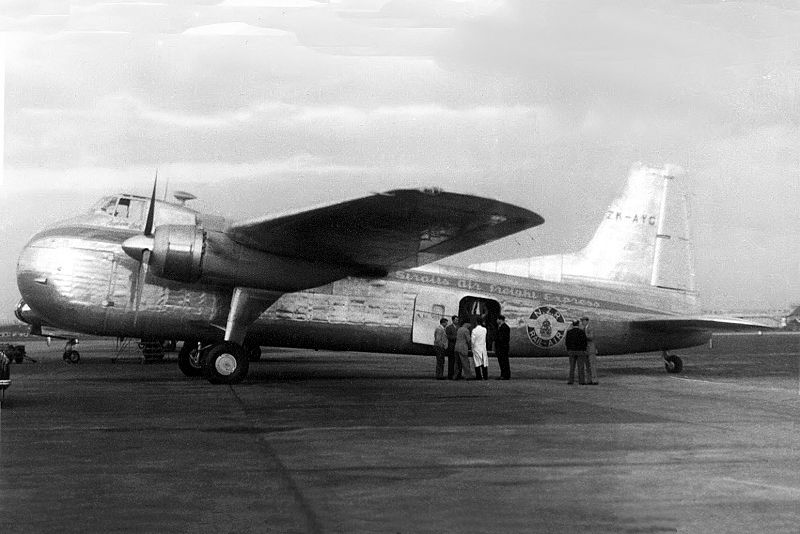
At Woodbourne, SAFE script has been removed (Dakman)

Open wide! ZK-AYG shows its teeth (Dakman)
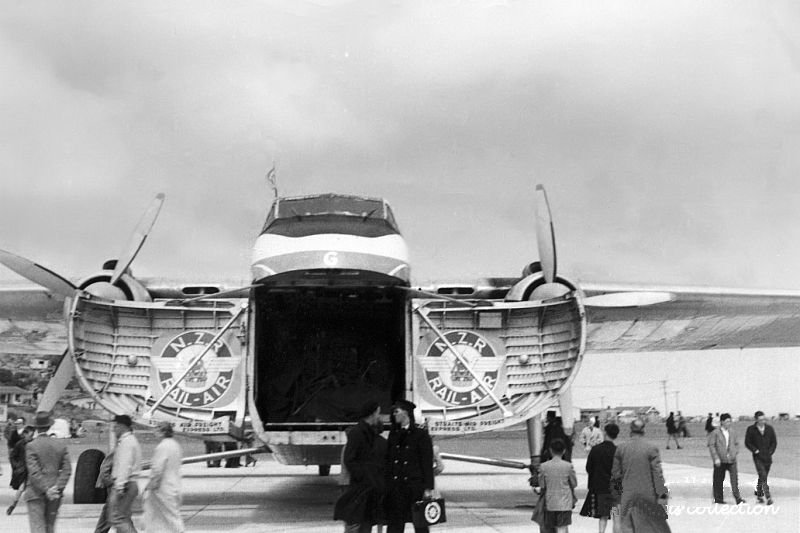
ZK-AYG at Woodbourne 1950s
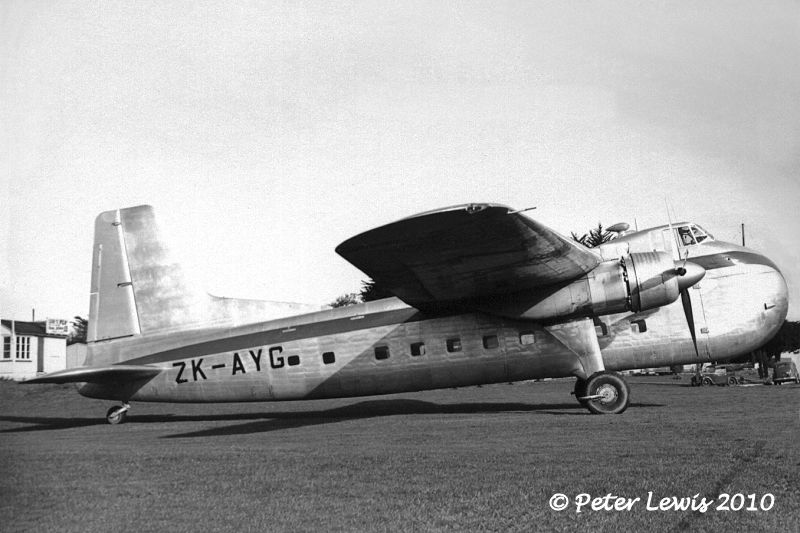
Ready to load freight at Nelson 19Jan1965, silver with dayglo trim. "Rail-Air" titles.
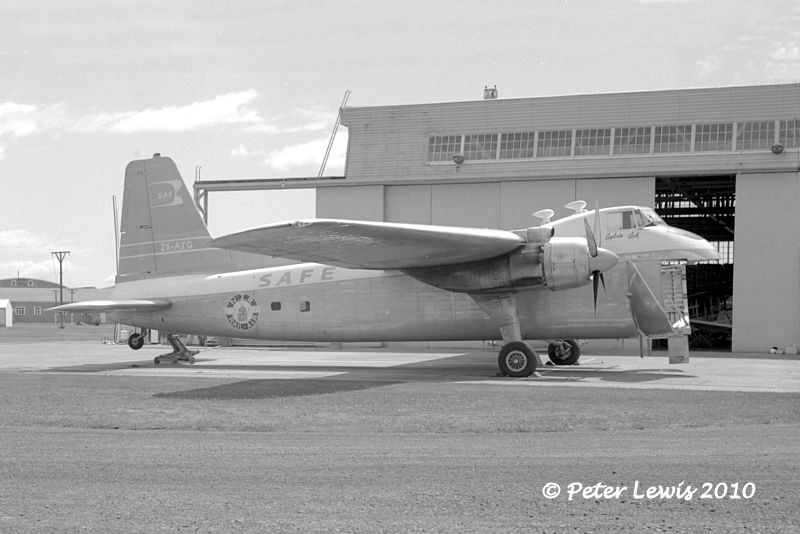
Loading completed, about to depart Nelson 19Jan1965. The 'Captain Cook' name is evident.
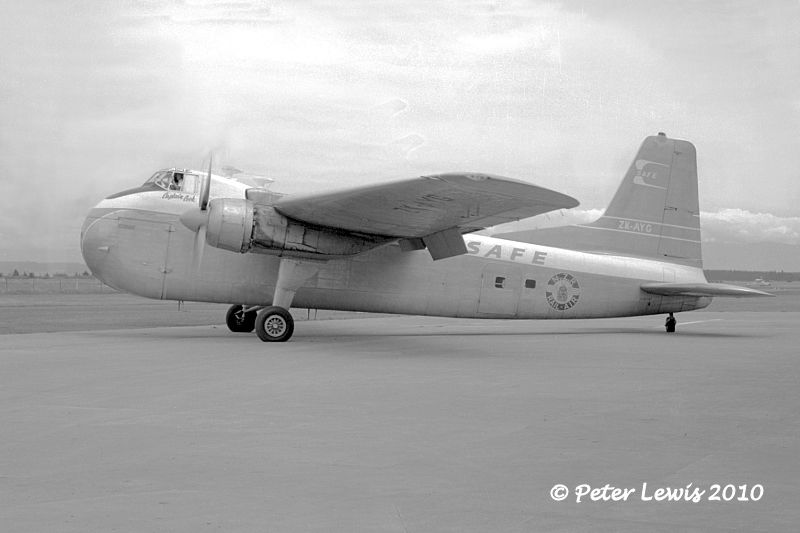
ZK-CWF at Rongotai 27Nov1979, white red & silver
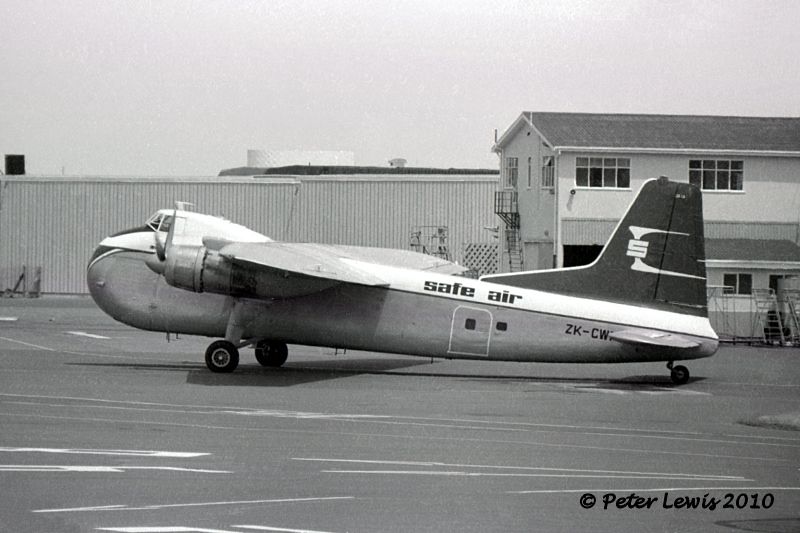
The second Freighter for Straits Air Freight Express was c/n 12828 which had been allotted the Bristol registration G-AINR prior to becoming ZK-AYH on 8Mar1951. It arrived at Woodbourne 19May51 and entered regular service on the 31st, bearing the name 'Endevour'.
This Bristol served less that seven years with SAFE before it crashed on the Russley Golf Course, Christchurch, 21Nov57 @ 7802hrs. Registration cancelled 3Mar1958.
From ICAO Accident Digest:
"The Bristol departed Blenheim-Woodbourne Airport (BHE) for a cargo light to Timaru (TIU) via Paraparaumu (PPQ). At an altitude of 2500 feet the no. 2 prop was feathered and rate half turns were made in both directions. The prop was unfeathered and normal power restored on the engine. Two minutes later a sudden and severe vibration was felt throughout the aircraft. When the no. 2 prop had been feathered again a little later, no vibration was felt on the remainder of the flight to Paraparaumu. After loading cargo the aircraft then continued to Timaru. At 11:27 the crew contacted Harewood Tower, reporting 6 miles North of Waimakariri River mouth at 3000 feet. Harewood cleared the aircraft to maintain 3000 feet to the Harewood Range Station, descend VFR and proceed to Timaru. At 11:33 eyewitnesses saw the aircraft at about 2000 feet when the right hand outer wing folded upwards and backwards and separated, falling and landing on open farmland. The nose doors, the floor of the freight compartment (with the freight in position), and the rear portion of the fuselage with the fin and rudder attached, separated from the rest of the aircraft just before impact. Pieces were scattered over an area of more than a square mile.
The rest of the aircraft ploughed nose down into a row of pine trees on the south-east boundary of the Russley Golf Course. Here the flight deck and front section erupted in a huge sheet of flame and spread to the trees as the unused fuel sprayed over the area.
It was found out that a fatigue failure originated in the outermost 0,25inch bolt hole drilled in the wing front spar during the incorporation of Bristol Modification 1169. This modification prolonged the life of the aircraft to 10400 hours because it moved the point of stress concentrated in the boom to a new location. The modification was carried out on January 21, 1954 and the aircraft made 4880 flying hours since (while 7400 hours extended lifetime had been guaranteed).
PROBABLE CAUSE: "In-flight structural fatigue failure of the starboard front lower spar boom. The circumstances which made the accident possible were created by the assessment of a life which was materially in excess of the safe life. The error in life assessment stemmed from the fact that simulated operational conditions from which the lifeing data was evolved were not truly representative of actual operating conditions."
Bristol 170 Freighter Mk.31 ZK-AYH at Woodbourne 1951 shortly after arrival.
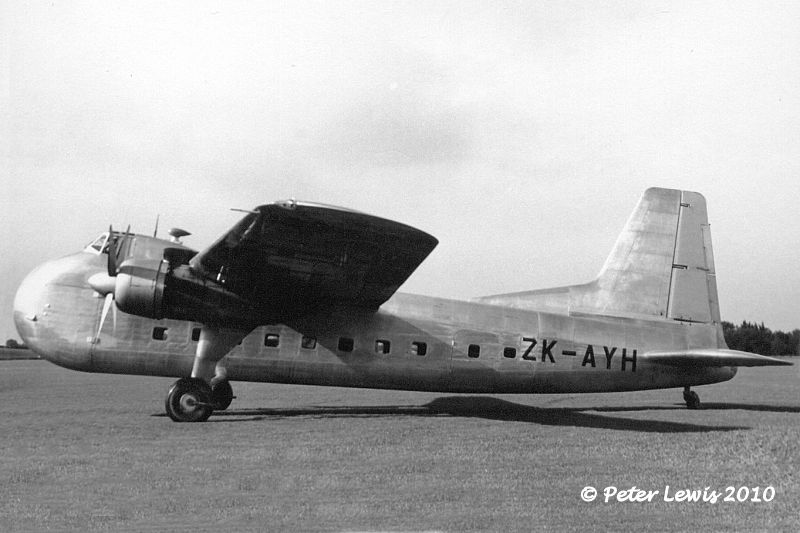
ZK-AYH with 'NZR Rail Air' titles (Dakman)
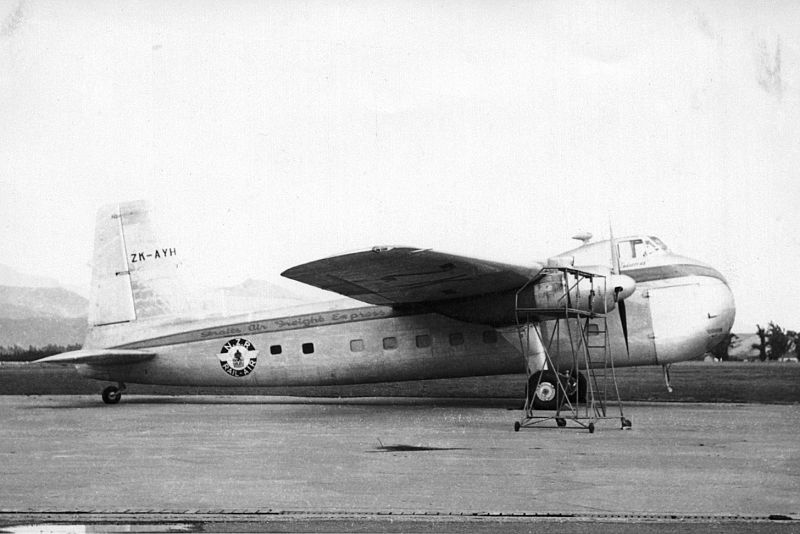
After the crash on Russley Golf Course, November 1957 (Dakman)
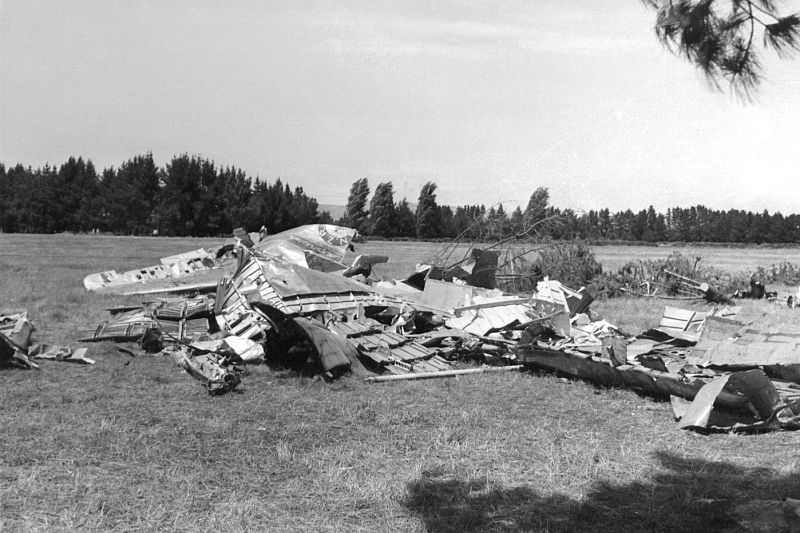
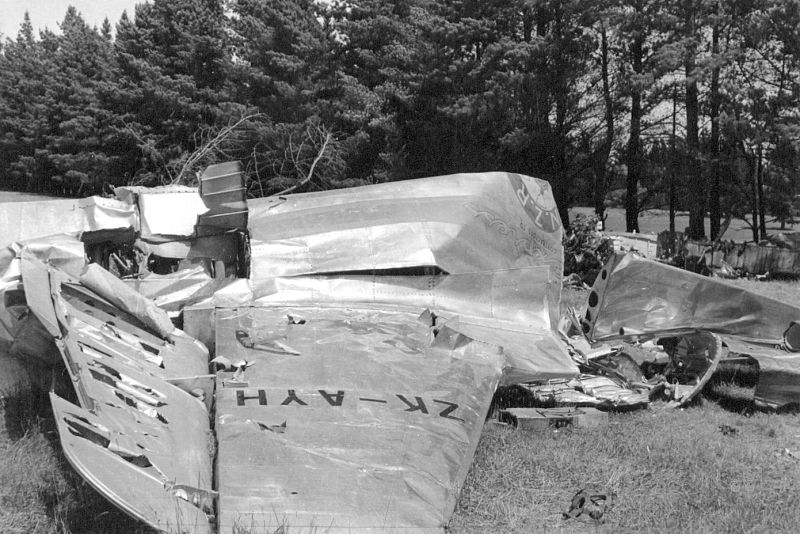
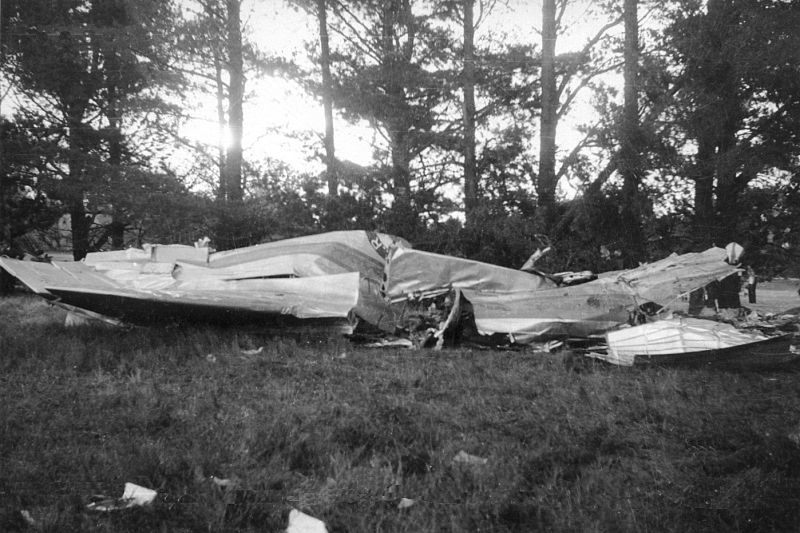
Meanwhile, over at Air Department the military had become interested in the Freighter's potential, and an order was placed for 11 aircraft as the Mk.31NZM.
The first of these, c/n 12832, had been allotted the Bristol registration G-AINR and was bought on charge by the Air Department as NZ5901 on 21Dec1951.
NZ5901 as a new aircraft, location looks to be Whenuapai
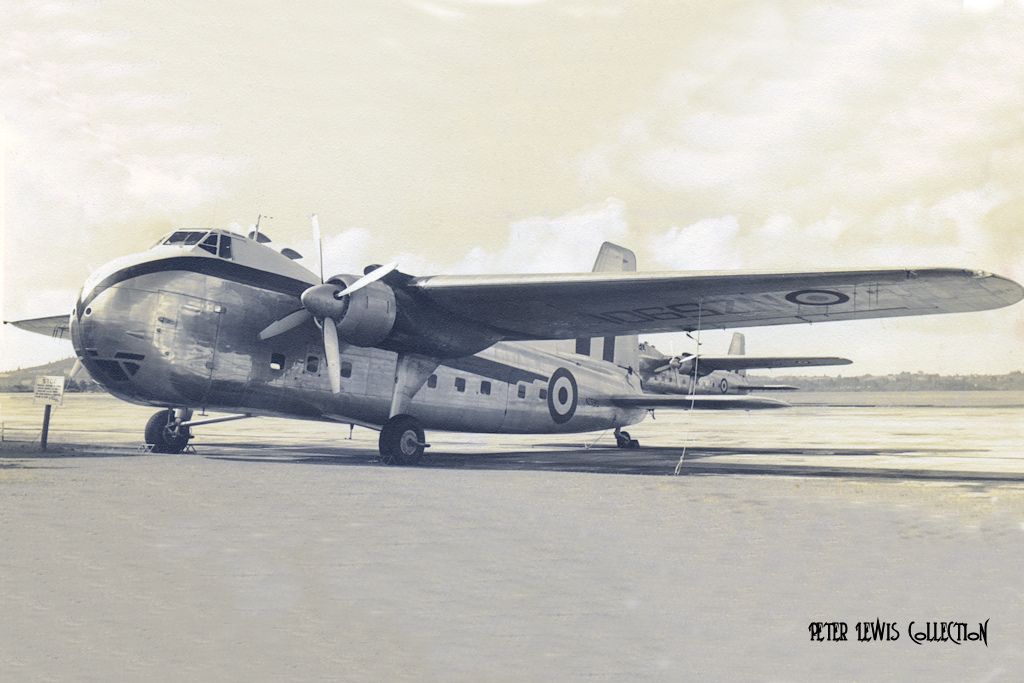
The aircraft was very badly damaged in a landing accident at Mauripur, Pakistan 19Apr1954 which required a rebuild (some say a new airframe) back at the Bristol works.
Returning to service in November 1955, NZ5901 was totally destroyed when it flew into a blind valley in poor visibility in the Cameron Highlands, Malaya, 10Dec1956.
NZ5901 after the crash landing in Pakistan 19Apr1954
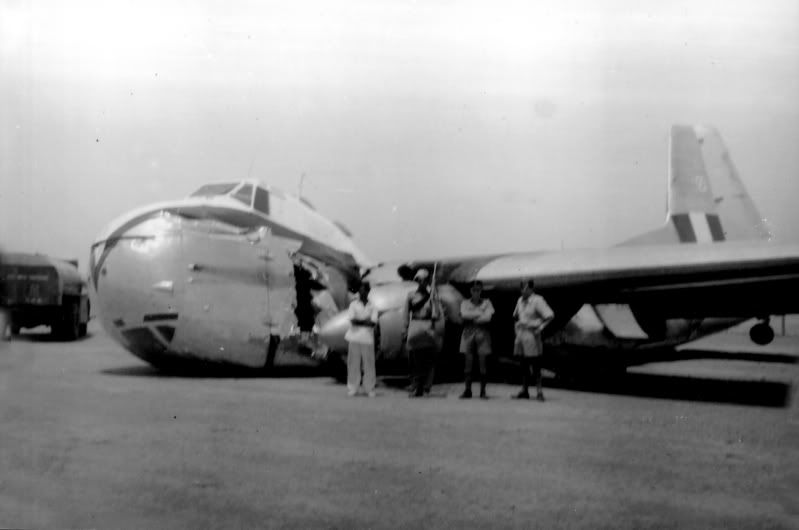
Photo Syd Vincent
As the civil and military histories of these aircraft are very closely intertwined, I will post this thread here rather than in the civil section.
As Kiwi as jandals, jelly tips and number 8 wire, the Bristol Frightener became an iconic feature of the local aviation scene over 40 years from the early 1950s. My favorite tall story involves an aviation person who visited Wellington during a fine weather day in the mid-1970s. At the conclusion of his visit he commented to his host on the Bristol that had been performing non-stop circuits at the airport for the entire day. He was astounded to be told that what he had seen was not one aircraft, but a parade of Safe-Air Freighters maintaining a continuous service across Cook Strait for the day, and that this was not an uncommon event.
The first B170 to be seen in NZ was G-AIMC 'Merchant Venturer' which arrived at Whenuapai in July 1947 on a Bristol sales drive. This aircraft was demonstrated to local operators and potential buyers during its visit, and carried the first Bristol freight operations across Cook Strait later that month.
Departing to Australia via Norfolk Island in August, G-AIMC was destroyed when its parking brake failed while on a steep strip in New Guinea in November 1947.
Freighter G-AIMC during its 1947 tour at Harewood (Dakman)

After Straits Air Freight Express Ltd. had gained the cross-strait freight contract from New Zealand Government Railways, initial operations were carried out by chartered Chinese Curtiss C-46 Commando until the two Bristol Freighters ordered by the new firm arrived.
The first of these aircraft was Bristol 170 Freighter Mk.31 c/n 12826. This had been built as a Mk.21 with the Bristol registrations G-18-92 and G-AINK. After military trials as WH575 it reverted to G-AINK and was badly damaged in a take-off accident at Filton, UK, 4Oct1950.
Rebuilt at the factory as a Mk.31 it was registered officially as ZK-AYG on the 8th March and was delivered at Woodbourne 19May51. Bearing the name 'Captain Cook'. ZK-AYG began line service on the 31st May.
This aircraft suffered several incidents over the years, including an overshoot at Paraparaumu on 14Nov1951, an aborted take-off at Woodbourne 3Feb954 (which required a repair back at the Bristol factory), and a descent into a riverbed near Woodbourne in August 1955. At a later stage, after returning to service following that incident, it bore the name 'Merchant Porter'.
ZK-AYG was finally withdrawn from use 9Sep67 @ 16768hrs. However it was then rebuilt with the wings off ZK-CLU and the new c/n R12826 as ZK-CWF being registered to Safe-Air Ltd. on 12Jan1968. It re-entered service with Safe-Air on 20Sep1968 bearing the name 'Merchant Freighter'.
This rebuilt aircraft then soldiered on until final retirement on 2Feb1985 when it had completed a total of 31996.43hrs. Registration of ZK-CWF was cancelled 12Mar1985.
The front section of the aircraft was salvaged and transported from Woodbourne to Christchurch where it is now on display at the Ferrymead Museum.
ZK-AYG in the UK prior to delivery, early 1951 (Dakman)

At Woodbourne, SAFE script has been removed (Dakman)

Open wide! ZK-AYG shows its teeth (Dakman)

ZK-AYG at Woodbourne 1950s

Ready to load freight at Nelson 19Jan1965, silver with dayglo trim. "Rail-Air" titles.

Loading completed, about to depart Nelson 19Jan1965. The 'Captain Cook' name is evident.

ZK-CWF at Rongotai 27Nov1979, white red & silver

The second Freighter for Straits Air Freight Express was c/n 12828 which had been allotted the Bristol registration G-AINR prior to becoming ZK-AYH on 8Mar1951. It arrived at Woodbourne 19May51 and entered regular service on the 31st, bearing the name 'Endevour'.
This Bristol served less that seven years with SAFE before it crashed on the Russley Golf Course, Christchurch, 21Nov57 @ 7802hrs. Registration cancelled 3Mar1958.
From ICAO Accident Digest:
"The Bristol departed Blenheim-Woodbourne Airport (BHE) for a cargo light to Timaru (TIU) via Paraparaumu (PPQ). At an altitude of 2500 feet the no. 2 prop was feathered and rate half turns were made in both directions. The prop was unfeathered and normal power restored on the engine. Two minutes later a sudden and severe vibration was felt throughout the aircraft. When the no. 2 prop had been feathered again a little later, no vibration was felt on the remainder of the flight to Paraparaumu. After loading cargo the aircraft then continued to Timaru. At 11:27 the crew contacted Harewood Tower, reporting 6 miles North of Waimakariri River mouth at 3000 feet. Harewood cleared the aircraft to maintain 3000 feet to the Harewood Range Station, descend VFR and proceed to Timaru. At 11:33 eyewitnesses saw the aircraft at about 2000 feet when the right hand outer wing folded upwards and backwards and separated, falling and landing on open farmland. The nose doors, the floor of the freight compartment (with the freight in position), and the rear portion of the fuselage with the fin and rudder attached, separated from the rest of the aircraft just before impact. Pieces were scattered over an area of more than a square mile.
The rest of the aircraft ploughed nose down into a row of pine trees on the south-east boundary of the Russley Golf Course. Here the flight deck and front section erupted in a huge sheet of flame and spread to the trees as the unused fuel sprayed over the area.
It was found out that a fatigue failure originated in the outermost 0,25inch bolt hole drilled in the wing front spar during the incorporation of Bristol Modification 1169. This modification prolonged the life of the aircraft to 10400 hours because it moved the point of stress concentrated in the boom to a new location. The modification was carried out on January 21, 1954 and the aircraft made 4880 flying hours since (while 7400 hours extended lifetime had been guaranteed).
PROBABLE CAUSE: "In-flight structural fatigue failure of the starboard front lower spar boom. The circumstances which made the accident possible were created by the assessment of a life which was materially in excess of the safe life. The error in life assessment stemmed from the fact that simulated operational conditions from which the lifeing data was evolved were not truly representative of actual operating conditions."
Bristol 170 Freighter Mk.31 ZK-AYH at Woodbourne 1951 shortly after arrival.

ZK-AYH with 'NZR Rail Air' titles (Dakman)

After the crash on Russley Golf Course, November 1957 (Dakman)



Meanwhile, over at Air Department the military had become interested in the Freighter's potential, and an order was placed for 11 aircraft as the Mk.31NZM.
The first of these, c/n 12832, had been allotted the Bristol registration G-AINR and was bought on charge by the Air Department as NZ5901 on 21Dec1951.
NZ5901 as a new aircraft, location looks to be Whenuapai

The aircraft was very badly damaged in a landing accident at Mauripur, Pakistan 19Apr1954 which required a rebuild (some say a new airframe) back at the Bristol works.
Returning to service in November 1955, NZ5901 was totally destroyed when it flew into a blind valley in poor visibility in the Cameron Highlands, Malaya, 10Dec1956.
NZ5901 after the crash landing in Pakistan 19Apr1954

Photo Syd Vincent


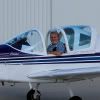

 I really find it hard to believe that they could really rebuild from that result, and it seems fate had already decided to take NZ5901 out of the picture as soon as possible.
I really find it hard to believe that they could really rebuild from that result, and it seems fate had already decided to take NZ5901 out of the picture as soon as possible. 


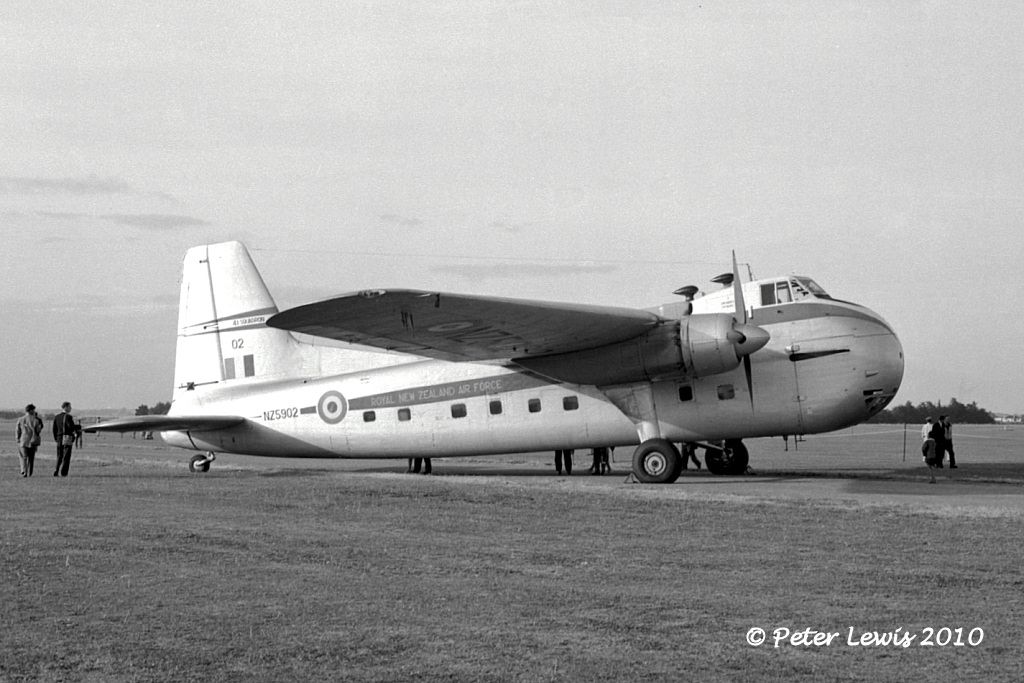
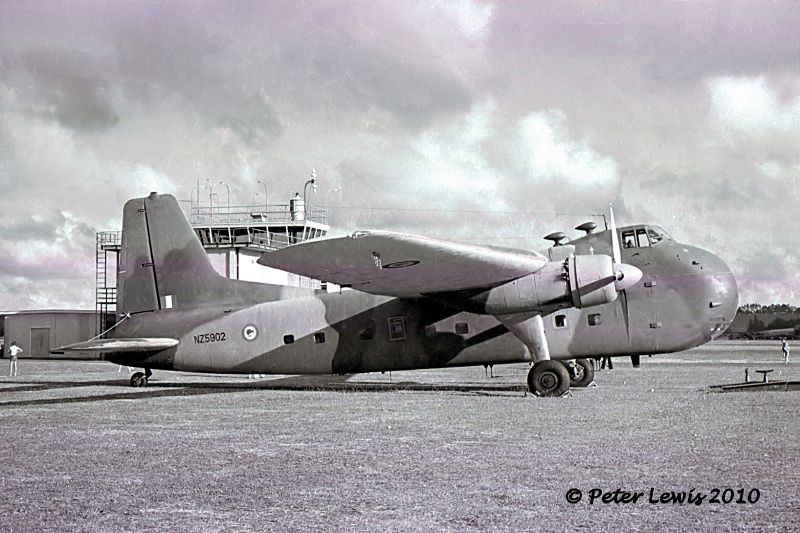
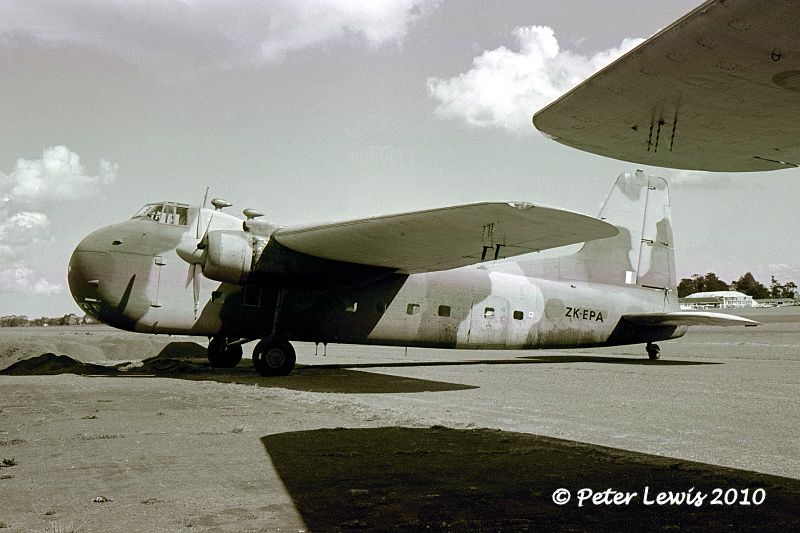
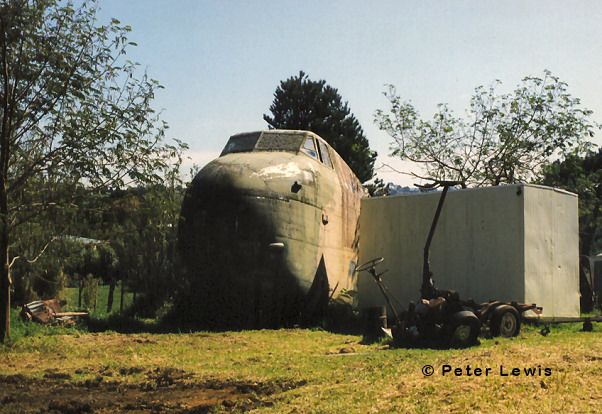
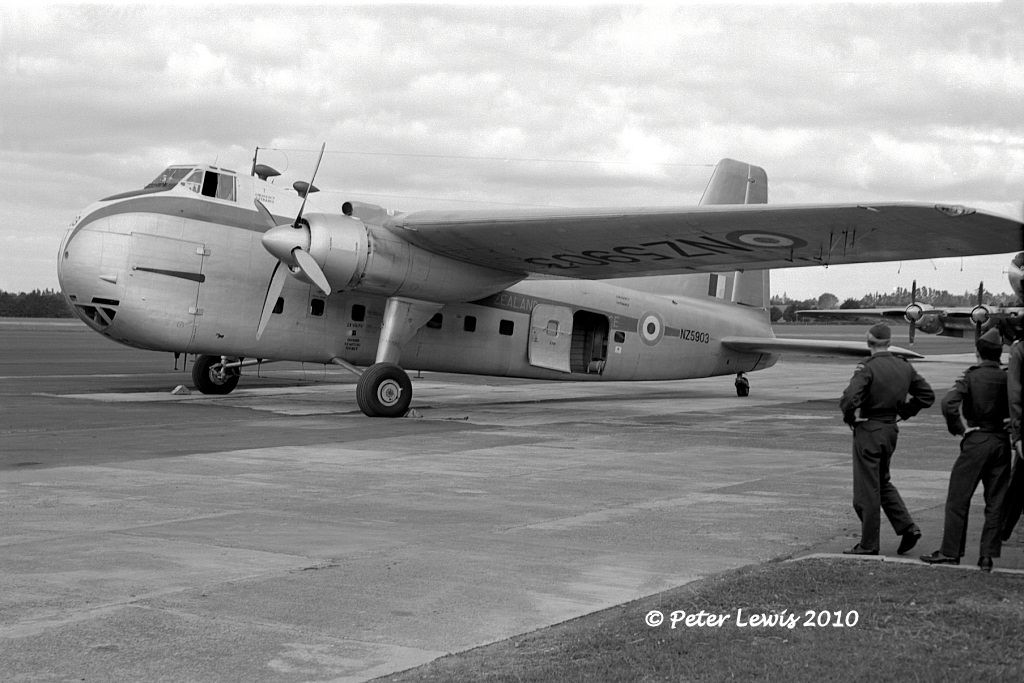

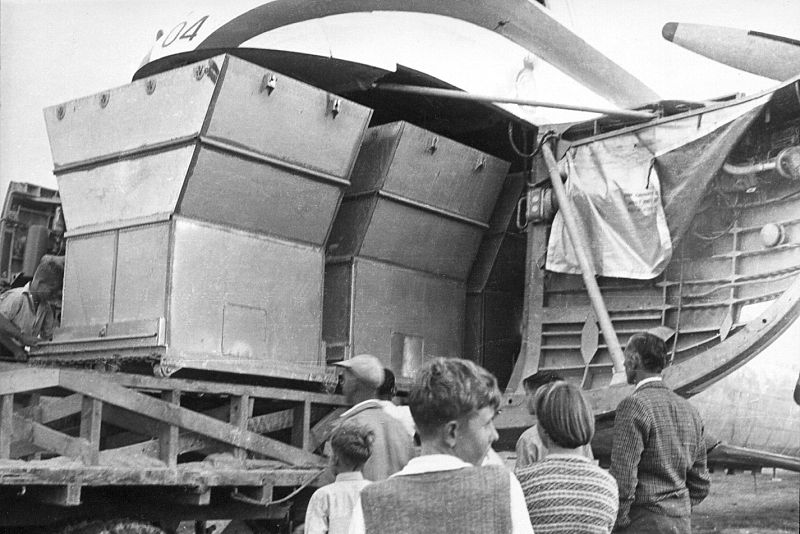
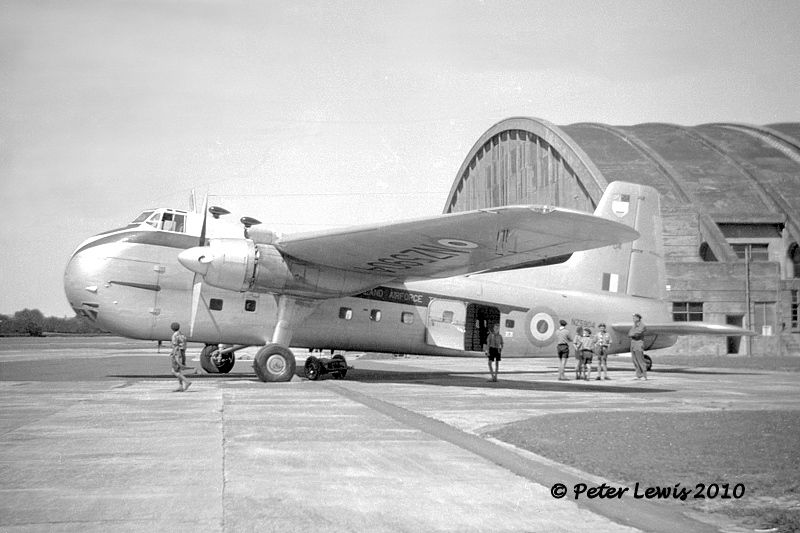
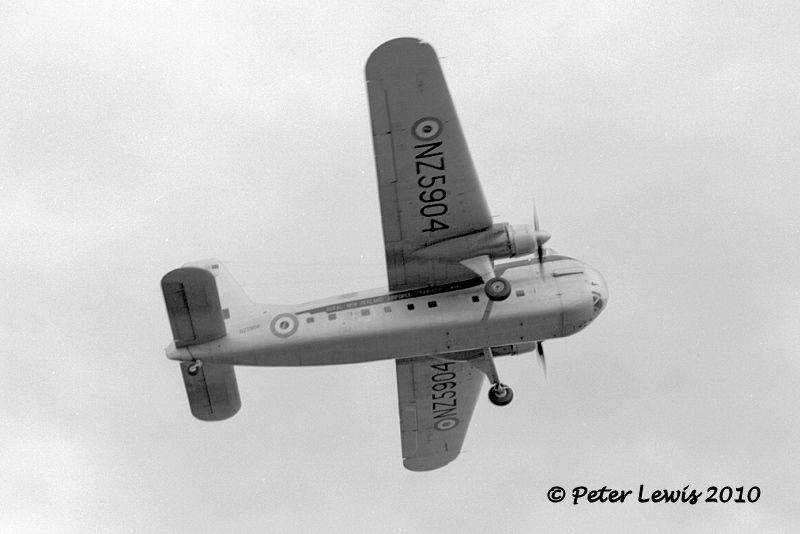
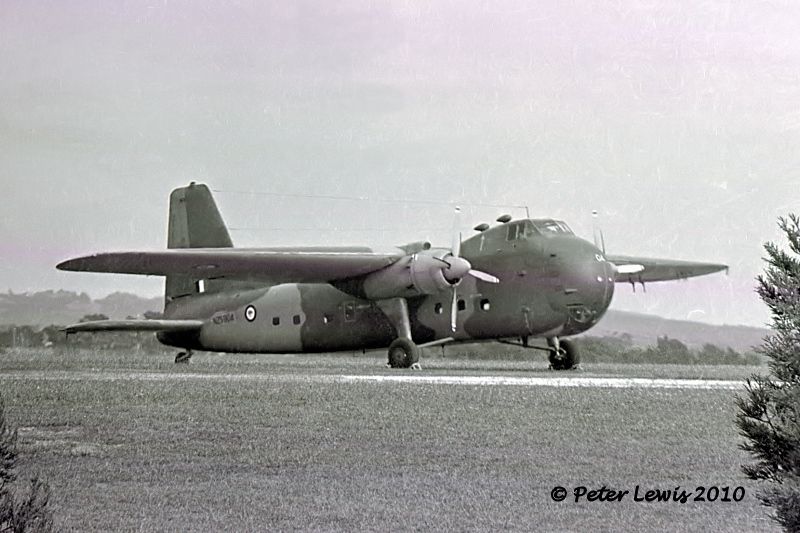
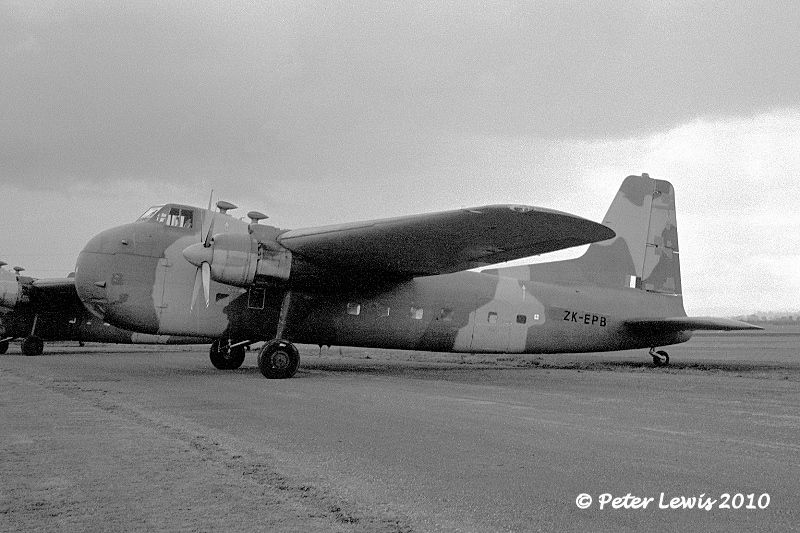

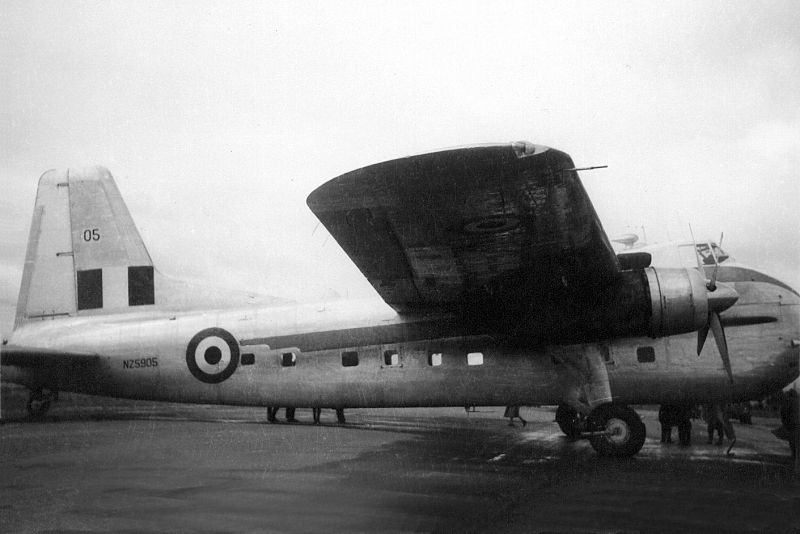
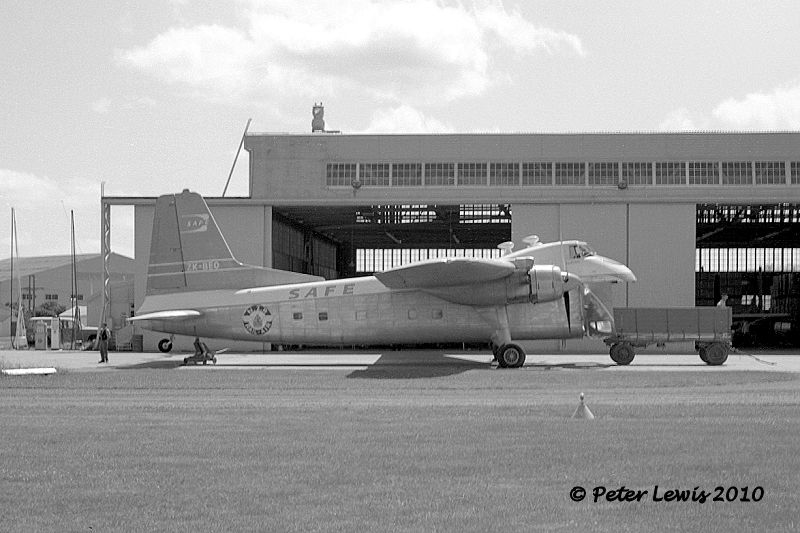
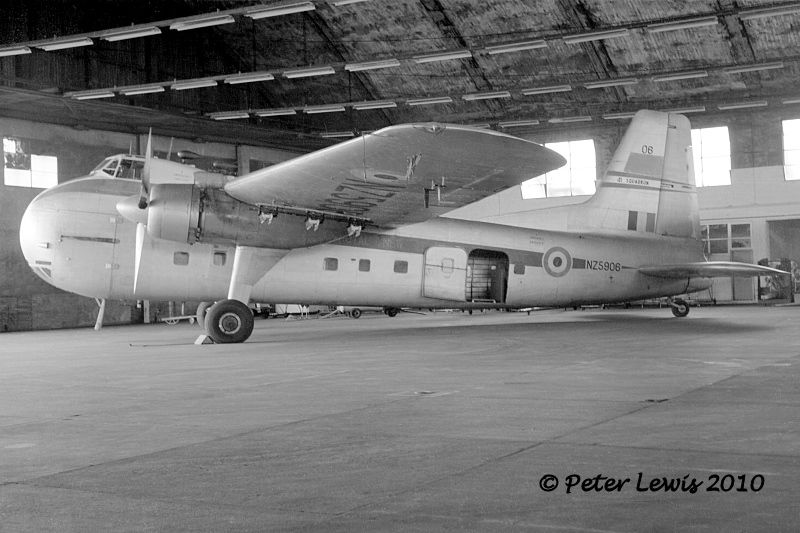
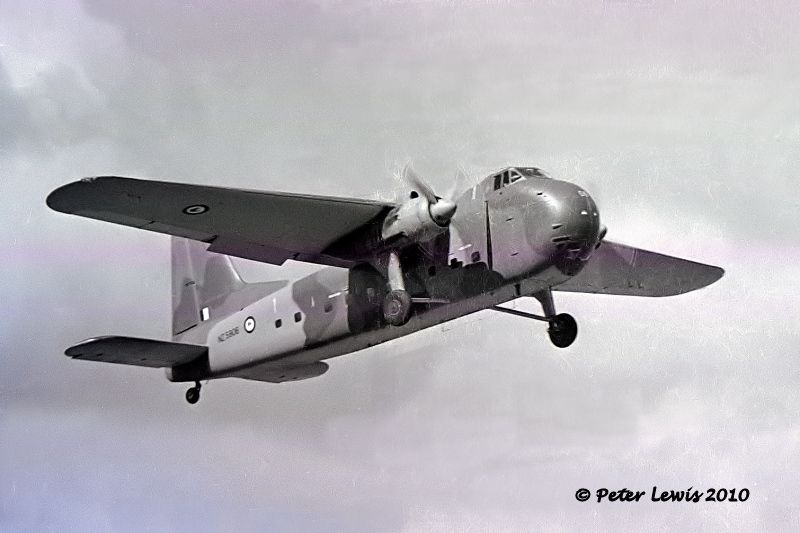
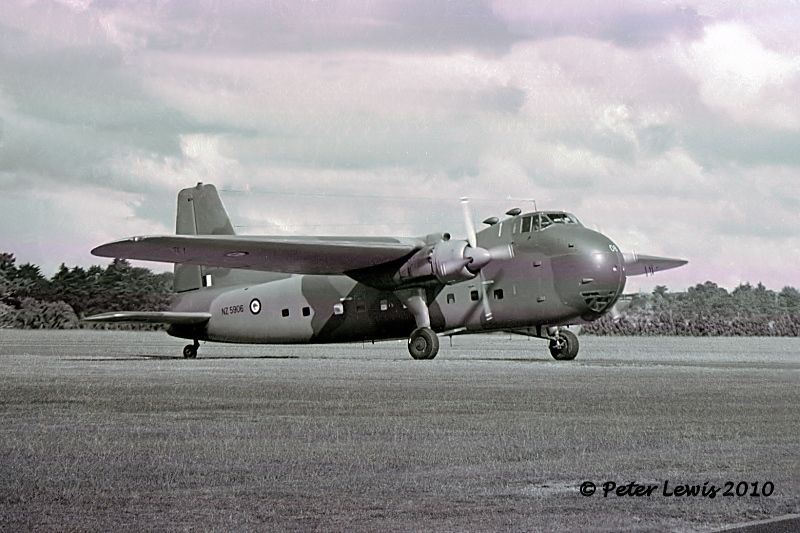
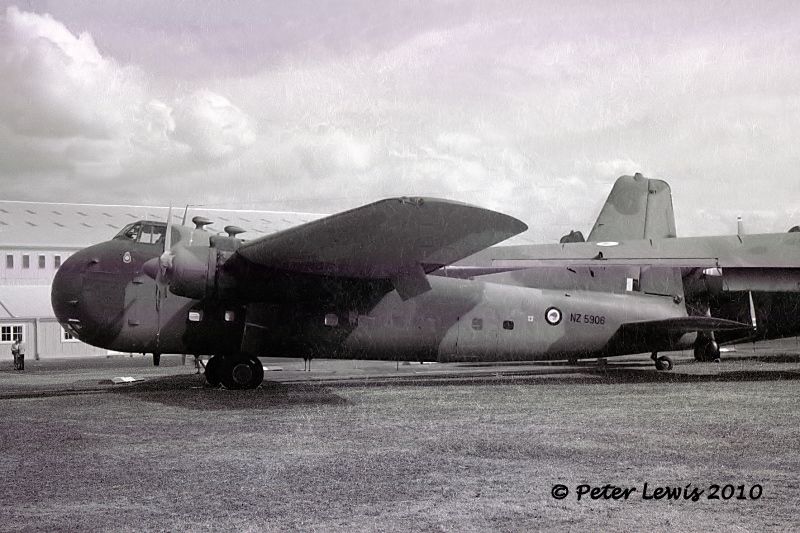

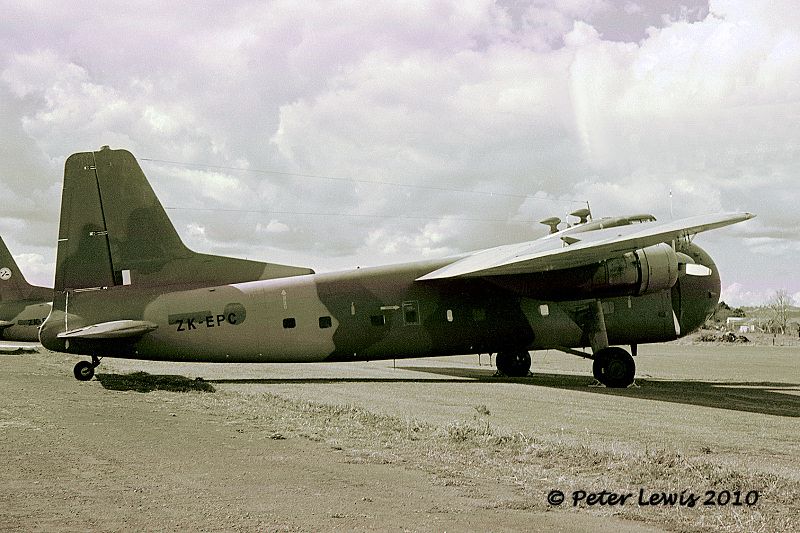

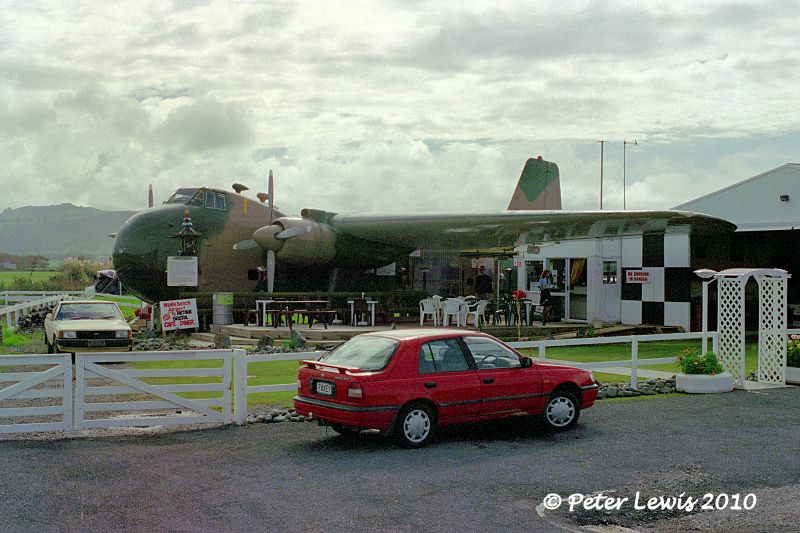
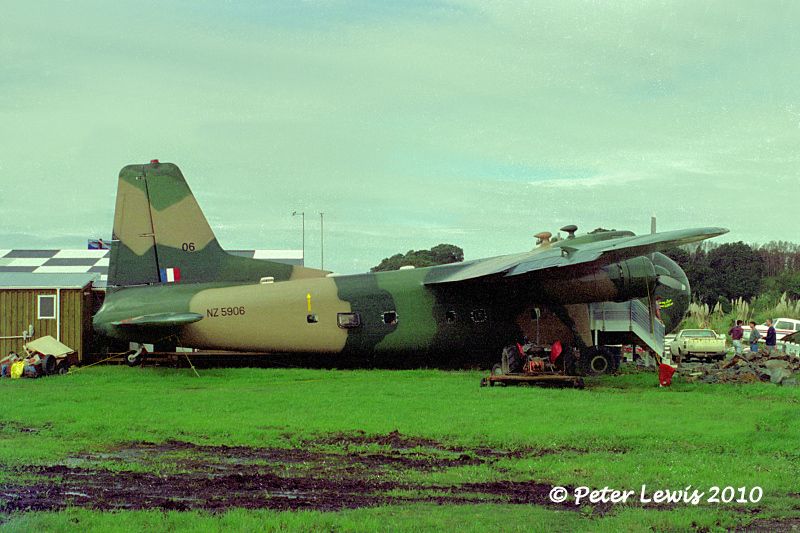
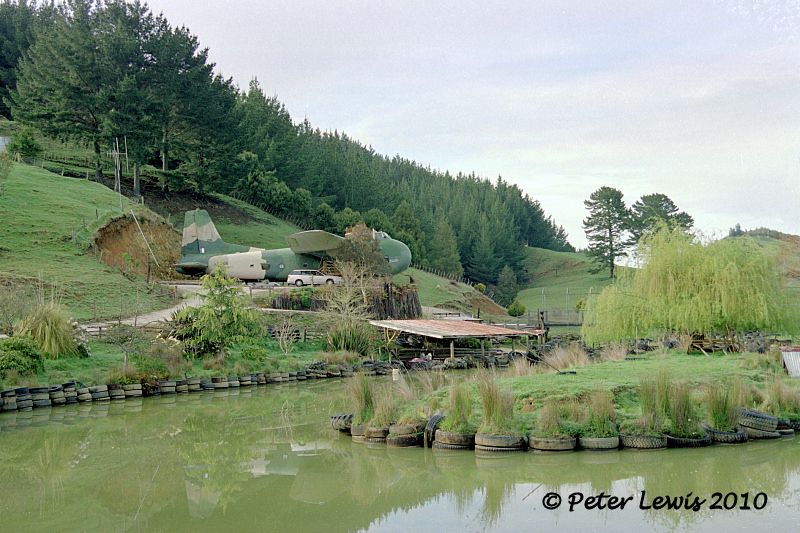


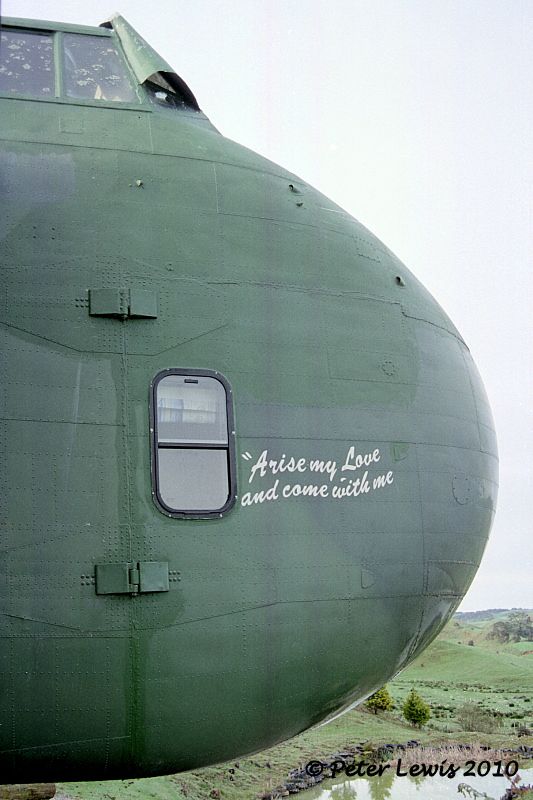
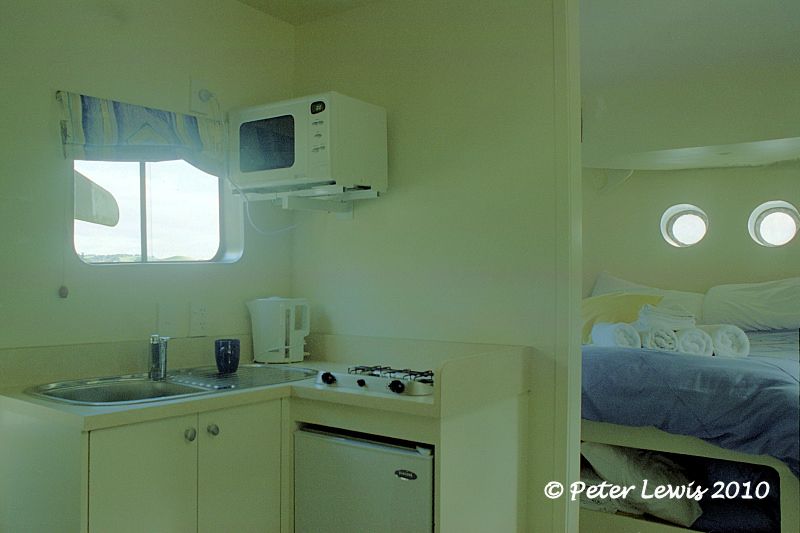
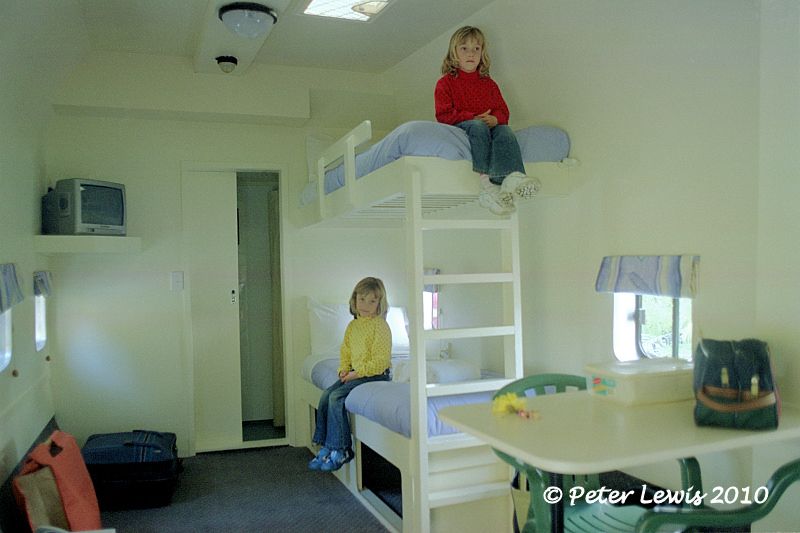

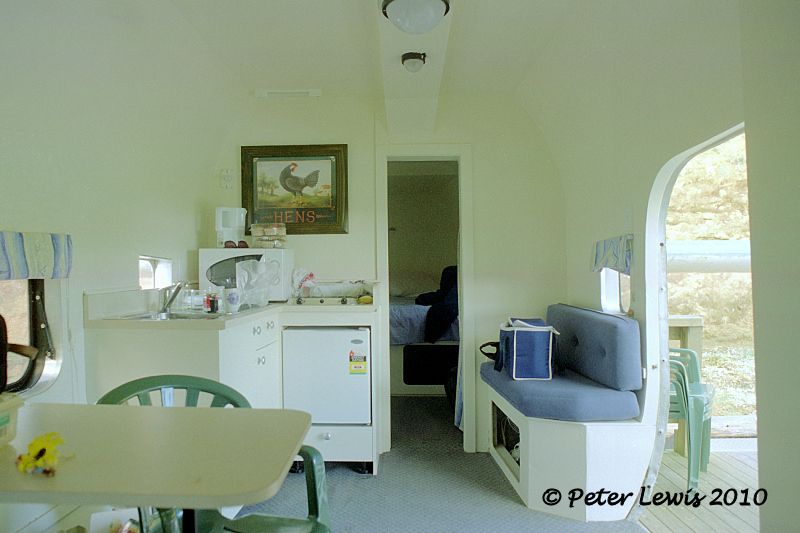 .
.